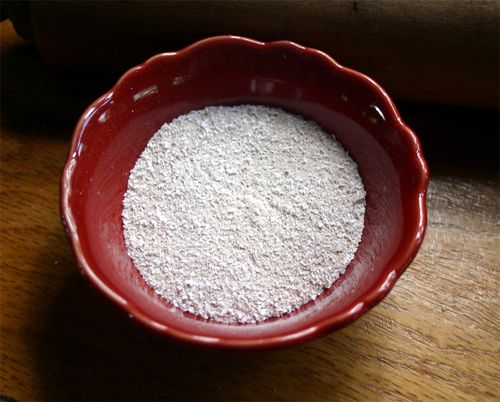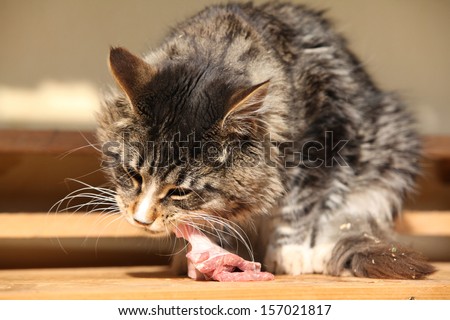ShopDreamUp AI ArtDreamUp
Deviation Actions

Group Rules & Guidelines | Best of CatCraze | Feline Info Links | Rarer Breeds Profiles | Cat Articles
B.A.R.F.
Biologically Appropriate Raw Food
© Written by Valvador
The Base
The idea of BARF is to feed cats the way nature wanted them to be fed. BARF is all about fresh and natural products – no synthetic or chemical features take place in BARF.The first and most important thing is physical state of the feed. Cat’s digestive system is designed by nature to absorb the water during the process of digestion. That’s why it is so important to keep the irrigation of the feed on the level that we can find in cat’s natural prey – which is 72%-75%.
The second (but not less important) thing is to keep the food properly balanced. To provide valuable feed to the cat, we need to follow some guidelines, which were made based off the analysis of a cat’s natural prey. The perfectly balanced meal for any cat is a mouse. And that is the goal that we try to reach while composing BARF meals – to make the meal as close to the mouse as possible.

Whole Prey Model
The Whole Prey Model is almost perfect. In this model, we use the whole body of an animal to feed our cat. If it is a small animal (for example: mice, chicks) that would be a cat’s prey in nature, that’s perfect. But it can also be bigger animals (for example rabbits) that we cut in half or more and feed to our cats in portions. Important thing is, that in this model we shouldn’t take anything out of the body – we feed the entire body with everything inside and outside, including bones, feathers, fur, internal organs etc. If your cat can’t digest any of these – it will be removed from the digestive system by vomiting. It may happen especially at the beginning of the diet and might disappear over time.In this model usually we don’t need to use any supplements, because we use every part of the body of the prey, but it is recommended to add some unsaturated fatty acids, as the balance of the fatty acids is usually unsettled in the bodies of farm animals. The perfect supplement is salmon oil, that we should add 10ml of the oil per every 1kg of the meat or 1ml of the oil per every 1kg of the cat’s weight. It is also good to add an egg yolk to the meal every couple of days. Some people advise to also add taurine to this model of diet, as it is essential microelement in a feline’s diet.

The BARF
This model is a little bit more complicated, but it gives us assurance of what our cat gets, which is important when we feed allergic or temporally or chronically ill cats. It also gives us the opportunity to feed our cats naturally if we don’t have the possibility (or simply we don’t have the guts!) to feed whole prey to our cats. In this model, we use natural supplements and calculators to turn the meat that we can buy (beef, chicken, turkey etc.) to create a mouse.To achieve this, we need to follow a few features:
Protein = 50-65%
Fat = 20-38%
Water = 72-75%
Carbohydrates = 5% or less
Fiber = 0,7%
The next thing is the balance of vitamins and microelements. A few of the most important are:
Calcium ~ 7949mg
Phosphorus ~ 6995mg
Calcium : Phosphorus ~ 1.15
Sodium ~ 5962mg
Potassium ~ 7949
Sodium : Potassium ~ 1,2-1,8
Iron ~ 149mg
Iodine ~ 1490µg
Taurine ~ 5962mg
Vitamin A ~ 49680 IE
Vitamin D ~ 745 IE
Vitamin E ~ 289 IE
Seems complicated, right? But it’s not! Believe me and keep on reading.



The Supplements
In BARF we use only natural supplements. They are not always the supplements that cat would catch and eat in nature, but they replace the organs of the prey that we can’t normally buy and feed to our cats. Usually we can only buy meat of muscles and a few kinds of organs – like heart, liver, stomach; of which heart and stomach are pretty much muscles and shouldn’t be treated like 100% organs. If we are lucky, we can buy lungs or kidneys. But still we lack the rest of the parts of the prey – brain, spleen, thyroid, blood etc. That’s why we need to use the supplements that will make the meal even.There are various kinds of supplements and it would take a lot more time than I’ve got to write and you’ve got to read to name them all. That’s why I will name only those that I use while preparing meals for my cats.
Egg yolk – natural vitamin bomb. I use one per every 1kg of the meat.
Liver – natural supplement of Vitamin A.
Salmon oil – natural supplement of unsaturated fatty acids. I use the oil of wild salmon (Grizzly), because it also gives me the source of Vitamin D. In this case (while using Grizzly), the converter I wrote about before (10ml per every 1kg of the meat etc.) is not any longer actually! We use only the amount of the oil that will provide the appropriate amount of Vitamin D in a cat’s diet.
Seaweed powder – natural supplement of iodine.
Brewer’s yeast – natural supplement of B Vitamins.
Dried blood – natural supplement of iron.
Eggshells powder – natural supplement of calcium. If you use bones often, you don’t need this supplement.
Himalayan salt – natural supplement of sodium. I don’t use the salt that you can buy at the grocery, because it’s full of chemicals and synthetic iodine which is not neutral to an animal or human’s health.
Taurine – it’s taurine itself. It’s probably the most important ingredient of a cat’s diet. The feline can’t survive without it!
If you don’t want to buy all the ingredients at the beginning of your adventure with BARF, you can also begin with the mix called Easy Barf. You can buy it online and it contains most of the supplements, but you will still need some other ingredients (like taurine) and some knowledge, to prepare a decent meal with EB.

The Meat
You can use the meat of any animal that you can buy, it just needs to be fresh, tested and raw. Varity is always indicated. 50-60% of the meal should be the meat of the muscles, the rest of it is organs and bones. The meat can’t be too rich in protein or too low in fat – beef chuck would be better than tenderloin, chicken leg better than breast etc. The proportions between protein and fat should be as close as possible to 2:1 and the amount of protein per 1kg of cats weight should be around 5-5,2g. If you use pork meat, be sure it’s not infected by Aujeszky’s disease.The Doubts
Don’t be afraid of bacteria like salmonella etc. – it is not a treat to the digestive system of a healthy cat. Nor are the bones, as far as they are raw. The important thing is not to feed dry food to the cats while feeding raw meat or bones. Dry food changes the pH in a cat’s stomach and makes digesting of the bones or deactivating of the bacteria almost impossible – if your cat eats dry food, bacteria and bones are serious threat to their health.You may also be worried about parasites, especially when you feed with whole prey model. If you are concerned about this, you can always deworm your cats with natural methods that are safe to a cat’s health, for example using herbs (like tanacetum) or diatomaceous earth.
The Calculators
You probably are wondering – how the heck can I make a proper meal? It may seem impossible, but there is an easy answer to the question. There are more than a few BARF Calculators that you can use to prepare the recipe of the perfect cat’s meal.Unfortunately, most of the calculators that I know are in German, but as the calculators use basic vocabulary, you can easily translate it on your own.
The database is every calculator slightly different, and so are the details of the guidelines – it is recommended to use alternative various kinds of calculators.

The Recipes
If it’s too complicated for you to make your own recipe you can always use any of the recipes that are available online.Here are some of my recipes that I made with Barfny Świat’s Calculators:
No 1 – Chicken
Approximate amount of food per day: 37g per every 1kg of cat’s weight
1000g Chicken leg with skin, without the bone
100g Chicken hearts
50g Chicken stomach
2 Egg yolks
35g Chicken Liver
14g Grizzly
1,9g Seaweed powder
2,3g Brewer’s yeast
22,5g Dried blood
6,8g Eggshells powder
4,7g Himalayan Salt
2g Taurine
406g Plain water
No 2 – Beef
Approximate amount of food per day: 37g per every 1kg of cat’s weight
1000g Beef, fat meat
150g Beaf heart
2 Egg yolks
42g Beef Liver
11g Grizzly
1,9g Seaweed powder
2,3g Brewer’s yeast
15,6g Dried blood
7,7g Eggshells powder
5,3g Himalayan Salt
2,5g Taurine
440g Plain water
No 3 – Turkey
Approximate amount of food per day: 37g per every 1kg of cat’s weight
1000g Turkey leg with skin, without the bone
100g Turkey hearts
50g Turkey stomach
2 Egg yolks
30g Turkey Liver
14g Grizzly
1,9g Seaweed powder
2,3g Brewer’s yeast
15,7g Dried blood
6,7g Eggshells powder
4,7g Himalayan Salt
3g Taurine
320g Plain water
No 4 – Rabbit & Goose & Chicken
Approximate amount of food per day: 37g per every 1kg of cat’s weight
700g Rabbit (meat)
250g Goose (meat with skin)
150g Chicken heart
2 Egg yolks
35g Chicken Liver
14g Grizzly
1,8g Seaweed powder
2,2g Brewer’s yeast
18,6g Dried blood
7,6g Eggshells powder
6,5g Himalayan Salt
3g Taurine
450g Plain water
Rarer Cat Breeds Profiles Recap
Group Rules & Guidelines | Best of CatCraze | Feline Info Links | Rarer Breeds Profiles | Cat Articles
:star: Rarer Cat Breeds Recap :star:
Here are all the "rarer" cat breeds we've covered over the past few years in case you've missed them or simply to refresh your mind. We would have liked to continue doing these for you but due to the shortage of cat breeds compared to dog breeds there were only so many to cover that were even considered rare enough.
Nebelung - May 2011
Toyger - June 2011
Siberian Forest Cat - July 2011
Selkirk Rex - August 2011
Khao Manee - March 2012
Singapura - April 2012
American Wirehair - May 2012
Serengeti
Looking for some new admins!
Group Rules & Guidelines | Best of CatCraze | Feline Info Links | Rarer Breeds Profiles | Cat Articles
:star:We're looking to add some more admins to our team!:star:
Do you know a lot about cats and/or work with them? Do you love cats as much as we do? And would you like to help us educate others about them? If this sounds like something you'd like to do, we're looking to add a few good people to our Contributors and maybe any members willing to volunteer writing articles if possible.
To find out more about this and if you have any questions or why you should be chosen, please direct all your inquiries via Note to t3hsilentone (https://www.deviantart.com/t3hsilentone). Please d
Rarer Cat Breeds - August and September
Group Rules & Guidelines | Best of CatCraze | Feline Info Links | Rarer Breeds Profiles | Cat Articles
Yet again, I have not gotten around to these so I am submitting them for both months missed. I hope you still enjoy these!
We are starting to run out of more "rarer" or less known cat breeds out there and need your help for new ideas for each month. Please tell us by commenting on this post or Noting us at the group. Thank you everyone.
:star: Rarer Cat Breeds Profile – August :star:
:: Donskoy(Don Sphynx) ::
General Description:
The Donskoy is in a class of its own. It is a highly intelligent, beautiful loving cat that looks dir
Rarer Cat Breeds Profile - July
Group Rules & Guidelines | Best of CatCraze | Feline Info Links | Rarer Breeds Profiles | Cat Articles
Again, I apologize for this being so late.
:star: Rarer Cat Breeds Profile – July :star:
:: Korat ::
General Description:
Korats are very special cats that are considered as a symbol of good fortune. Many traditions surround them: they are the color of silver, signifying wealth; they are the color of rain clouds with eyes the color of young plants representing good harvests; and with their heart-shaped faces, a pair of cats given to a bride ensures a strong and fortunate marriage. Their eyes are large, expressive and oversized for
Featured in Groups
© 2014 - 2024 CatCraze
Comments14
Join the community to add your comment. Already a deviant? Log In
Is there a similar thing for dogs by any chance? In the future, I want to try this because normally I feel my dogs Pedigree brand dog food, but I always worry about what the dog food has for them (I just can't switch because I can't afford any other different brand at the moment).
I just want to bookmark any BARF recommendations for my future hounds. ovo
I just want to bookmark any BARF recommendations for my future hounds. ovo
